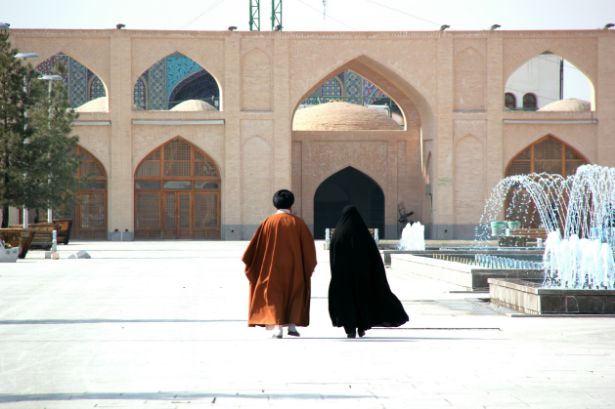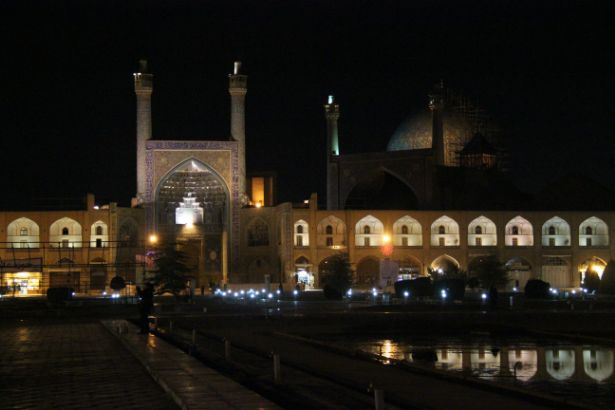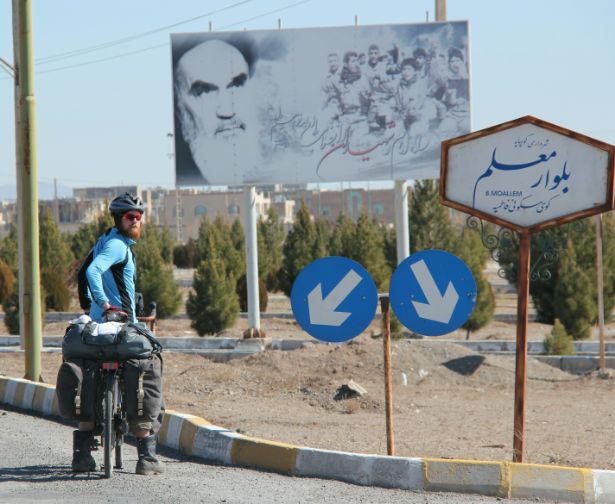The Good
The people
We had already been warned about the extraordinary levels of hospitality we should expect to find in Iran. After a month of cycling across the country, we can confidently confirm that the Persian reputation for generosity and warmth is well-deserved.
On our first night in the country, we were cycling around a town at 2am looking for our friend’s house.
Welcome to my country! This is my wife. This is my son. Would you like to come and drink some tea at my home?
This was our first interaction with a resident of Iran, the speaker being a car driver who shadowed us for a few blocks. Needless to say, we declined the offer (did I mention it was 2am?), but it was a great introduction to this country, whose reputation is so-often maligned in the west.
There was the lorry driver who mistook us for an old friend, but upon realising his error, invited us to his home to meet his wife and sister. We stayed with them for a couple of nights and he took a couple of days off work to show us round.
There was the family who made us extravagant meals and who, as we left, emptied every bowl of oranges, dried fruit and nuts they could find in the house into our panniers.
And there were countless strangers who leaned out of their car windows to shout ‘Welcome’, ‘Where are you from’ or our favourite, ‘I love you’.
In fact, our single unpleasant encounter in Iran was with a man who wouldn’t take no for an answer when he invited us home with him. We wouldn’t usually decline such an invitation but he was so aggressive about it that we preferred to sleep in the half built mosque he found us in.
The cities
Esfahan. Qom. Tabriz. Kashan. Yazd. Shiraz. Persepolis.
Iran’s cities are a living monument to its past glories.
Turquoise-tiled minarets, golden domes, graceful arches – this is the stuff of which architectural dreams are made. Bazaars still sell the woven carpets and reams of fabric which made Persia such an important Silk Road stop, these days alongside fake iPads and phone chargers. Women clad in the chador, a long black robe designed to cover one’s body shape, hurry past as they do their shopping and all we see is a glimpse of their face under the hijab. In contrast, other women saunter past arm in arm with their headscarf perched high on their head, barely covering the elaborate hairstyle at all. All women must dress modestly by law, but these ladies manage to look extremely stylish with their belted manteau coats and skinny jeans.
Whenever we need an escape from the crowds, peaceful gardens designed on classical Persian principles offer an oasis. Alternatively, we slip into a traditional restaurant with its central fountain, painted walls and vaulted ceiling, where we enjoy glasses of black tea, sipped through a sugar cube held in the mouth.
The countryside
A friendly Armenian girl on the bus across the border raved about the landscape we were about to discover:
Iran, too much beautiful.
She was totally right. Spiky snowcapped mountains, wild expanses of desert, isolated mud-brick villages glowing orange in the setting sun – Iran is a beauty to behold. With several easily accessible peaks over 4,000m and some great cycling, it is an also outdoorsy dream.
The food
Iranian food can be a real treat.
Chewy sangak bread, baked on pebbles in a clay oven. Piles of rice, spiked with bright red barberries to add tiny bursts of flavour. Roast chicken covered with a rich sauce made of walnuts and pomegranate molasses, known as fesenjun. All finished with soft dates, more like caramel than fruit, and sweet gaz nougat, flavoured with pistachio and rose water.
Best of all is the fruit and nuts. Oranges and pomegranates were some of the nicest we’ve ever tasted and even the lemons are sweet, with a variety that can be peeled and eaten without wincing.
The Bad
The people
OK, so bad is a bit strong. No Iranian person we met could be described as bad – in fact, quite the opposite. Most of them were lovely. There were just a couple of aspects of the culture that we found rather challenging.
How do you find our country? What did you think of it before you came here?
This question was repeated several times each day, every day, during our month in Iran. It was asked by young people, old people, men, women, friends and total strangers. It is perhaps no surprise given that people are well aware of Iran’s reputation in the West, but the national insecurity complex can become a bit wearing on the visitor. It’s a bit like a needy boyfriend who constantly needs reassuring that you like him.
It could also be rather claustrophobic. When staying with people, we were rarely given a moment to ourselves and our every move was monitored. If it was cold outside, our hosts would tell us again and again that we shouldn’t leave the house (no matter that we had cycled to them and had camped outside in much colder temperatures). If we were given tea, we were told when it would be cool enough to drink (no matter that we’re British and have been drinking tea practically since birth). If we refused food, we were asked why (no matter that we had just eaten a huge meal).
This may be a reflection of the way Iranian society operates, where most families are very close knit and independent living a relative unknown. One friend tried to move into his own flat, only to have his mother follow him and refuse to leave unless he came back home to her. People know each other’s business and interfere in each other’s lives. This rule of the family was simply being applied to us.
Being constantly stared at and shouted to could also be extremely tiring, especially at the end of a long day of cycling when blood sugar is low and hands are numb. Worst of all was the car horns – every few seconds (no exaggeration), cars and lorries would honk in greeting, perhaps with a wave. On several occasions, a car would overtake and then pull up in front of us so the inhabitants could get a better look at us. Usually, this meant we had to swerve out into the traffic to get round them. Annoying, tiresome and ultimately dangerous.
However, I must finish this rant on a kinder note. Foreign visitors are a huge novelty for most Iranians as tourists are uncommon, especially outside the major cities. The chance of travelling to the West is also a slim one for most Iranian people, given the visa and financial issues involved. Excitement at being able to talk to an outsider about the perception of Iran outside the country and to practise speaking English was understandable and we endeavoured to cover any irritation we felt with a smile. Several times, we were made to feel ashamed of our ungrateful bad temper by a car driver who waved us down because they wanted to give us a gift: sweets, water, fruit or on one occasion, a baby. At least the experiences taught us patience – a bit.
The cities
Heavy manufacturing and old, inefficient vehicles (partly a result of international sanctions) mean that Iranian cities are polluted. Really polluted.
Huge traffic jams and buses pouring out fumes means the urban air is often thick with claggy air and a yellow smog hangs over the towns. Saying this, we had the same problem pretty much constantly between Albania and Iran, so Iran is not exceptional in this regard.
The countryside
Much of Iran lies on a plateau of 900m+. Massive mountains run down the western spine of the country, and although one can follow the valleys for much of way, crossing at least a few mountain passes is pretty much unavoidable. Coupled with the poor quality of the roads, the terrain can be tough going for the cyclist.
However, we can’t really complain about this – and appreciate that other, more hardcore cyclists would actively seek out the biggest mountains to pedal over. The views are stupendous and many of the hill climbs were actually a lot of fun.
The food
Kebab and rice. Rice and kebab. Rice. Kebab. Rice. Kebab.
Away from the major cities, cafes and restaurants largely offer the same basic fare. Even in the cities, the most common option is greasy fast food, with doughy pizzas and burgers on offer. There are a few fantastic restaurants, but these are just not that easy to find.
To taste Iranian food at its best, you really need to visit someone’s home. We were lucky to have this honour, but we met people who were hopping between city hotels who complained bitterly about the repetitive cuisine.
The Downright Crazy
The reputation of the Iranian government hardly needs introducing, such is its infamy. Its repressive policies towards women are a particular issue I struggled with. I would support any women who chooses to wear the hijab, but the key word in that statement is chooses. Any country which insists on covering its women as a matter of law, with morality police to pull up those who dare wear too much makeup or too little scarf, is not a place I would wish to live. I would even think twice before returning to visit as a tourist, which is a tragedy when Iran has so many attributes to offer.
The law is outright discriminatory against women in many other ways. A woman is worth far less than a man in matters such as criminal law, where the ‘blood money’ paid by a murderer to a victim’s family is half the price if the victim was female, and a woman’s testimony is given half the weight of a man’s in court. The rape laws are also offensively unjust, where a female victim must provide several witnesses or else face a charge of adultery (for which she could be stoned to death).
Paternalistic attitudes towards women are also tightly woven throughout the fabric of society and we encountered several men with somewhat ‘challenging’ views (although happily we did meet a few others who were as liberal and progressive as any man back in the UK). We were told several times (by men) that women like wearing the chador as it stops men from bothering them. I’m sorry, but apart from the odd wolf whistle in my younger days, I’ve never been hassled by random blokes in the street. If that is a real risk, it’s a problem with your menfolk, not your women.
The political leadership is certainly a little crazy and there is something of a cult surrounding Ayatollah Khomeini, despite his death several years ago. His photo is everywhere and television footage of the Islamic Revolution, when he took over the leadership, is played on loop. He was certainly a charismatic leader, persuading scores of young men to suffer a martyr’s death, for example, by walking over mine fields to clear them during the Iran-Iraq War. Posters similar to the one above are found in every town, with Khomeini pictured next to the various martyrs from that locality. A leader who can move crowds to tears by talking of his own death, and who still has such an impact on day-to-day life even from the grave, is an unsettling figurehead for those of us with a healthy cynicism about elected authority.
The country is effectively a religious dictatorship in many ways. Despite having an elected president, the Supreme Leader wields an inordinate amount of power, controlling judicial and political appointments, and any president who tries to reform the country is quickly clamped down on. While we were in Iran, there were several announcements about the discussions taking place with the USA to restrict Iran’s development of nuclear power, led by the current President Rouhani. The hugely biased media reported the news by showing images of Iranian war ships moving to the coast of America, accompanied by endless footage of Iranian missiles being launched. The message was clear: Rouhani might be giving in the American superpower, but Iran still has the military upper hand.
Several Iranian people we met were outspoken in their criticism of the Iranian leadership. The first guy we stayed with memorably responded to our questions by saying ‘F**k religion’, just before he downed a shot of (illegal) vodka for breakfast. With sanctions pushing up prices of everyday essentials and increasing levels of poverty, it seemed to us that Iran is heading towards an inevitable Persian Spring. However, people seemed to be fairly despondent about the possibility of change, as the government holds the reins of power so tightly. Who knows what will happen in the future.
Overall, our visit to the Islamic Republic was a fascinating one. We were frustrated, irritated, awed and humbled at every turn and it has definitely been one of the highlights of our trip so far.



What do you think? Please do add your thoughts below…